
How Do We Get Started and Integrate AI? A Practical Guide for B2B Executives
July 21, 2025 / Bryan ReynoldsIn executive suites and boardrooms across the globe, the conversation around Artificial Intelligence has shifted from "if" to "how" and "how fast." The pressure is immense. On one hand, the data is undeniable: 82% of businesses now view generative AI as a primary lever for reinvention, a fundamental shift in how work gets done. On the other, the path forward is shrouded in complexity, with a staggering 76% of business leaders admitting that AI implementation is challenging. This isn't about simply adding new tools; it's about fundamentally reimagining core business processes.
The urgency is palpable. The global AI market, valued at nearly $400 billion in 2024, is projected to exceed $1.8 trillion by 2030, expanding at a blistering compound annual growth rate (CAGR) of around 37%. In this environment, companies that are not actively implementing AI at scale are not just falling behind—they are becoming competitively vulnerable in real-time.
This guide is designed to cut through the hype. It is a practical, executive-level manual designed to answer the most pressing questions B2B leaders have: Where do we start? How do we integrate it with the systems we already have? And what will it really cost? For many, the path from strategy to execution is fraught with technical and operational hurdles. It's a journey that often requires a seasoned guide—a partner like Baytech Consulting, which specializes in developing the custom software solutions that bring AI strategies to life.
Is AI Really a 'Must-Have' Now, or Can We Wait?
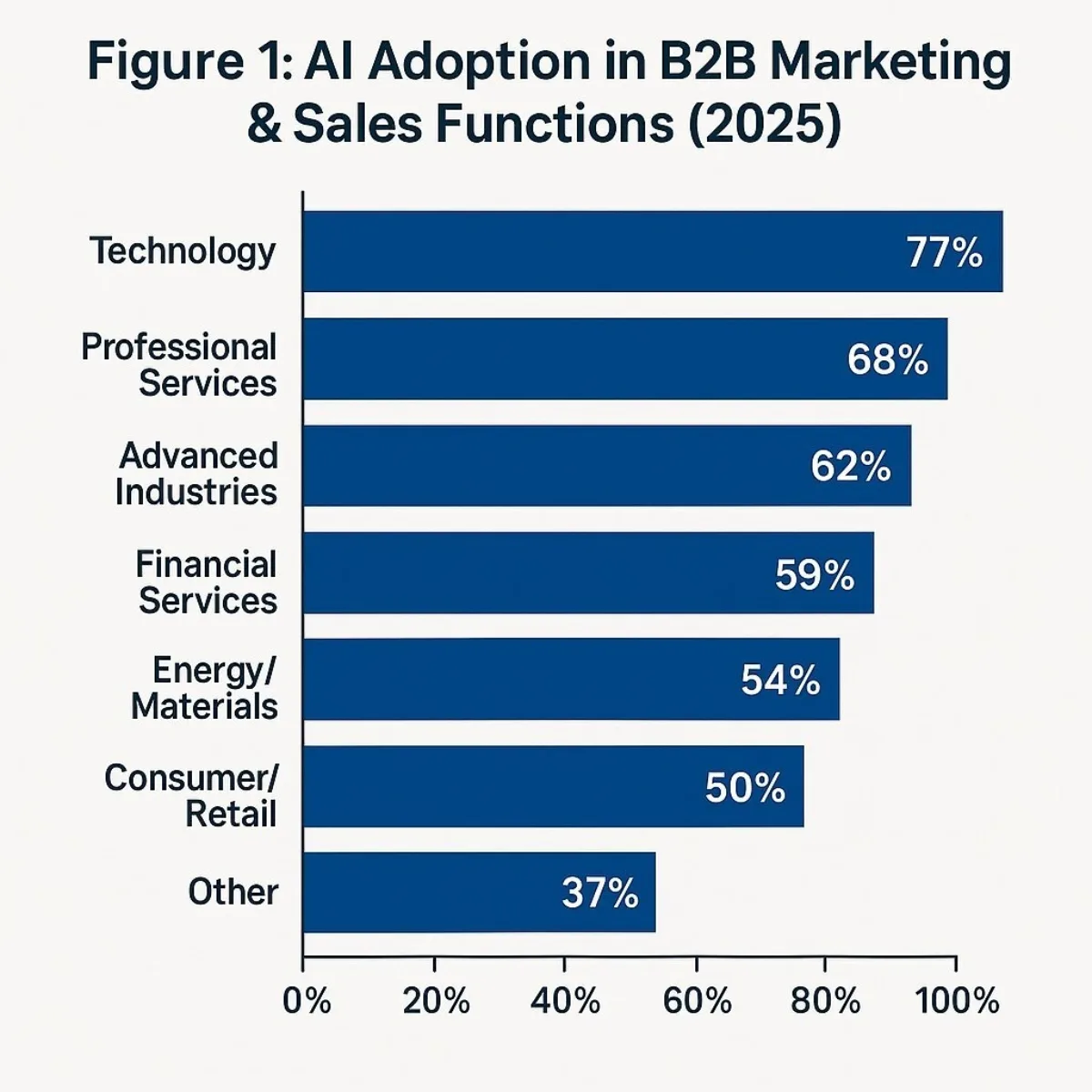
For any executive evaluating a major strategic investment, the first question is always one of timing and necessity. The data on AI adoption provides an unequivocal answer: the time is now, and waiting is no longer a viable strategy.
The adoption rates alone tell a compelling story. In 2024, 78% of organizations reported using AI in at least one business function, a sharp increase from 55% just a year prior. The uptake of generative AI (GAI) is even more explosive, with 71% of firms now using it in at least one function. This is not a fringe movement; it is a mainstream business reality.
This transformation is being led from the top. A stunning 83% of companies now claim AI is a top strategic priority, and the weekly use of GAI among business leaders has nearly doubled in the last year, from 37% to 73%. This executive buy-in is translating directly into budget allocation, with 92% of companies planning to increase their AI investment over the next three years. This isn't a fleeting trend; it's a long-term strategic commitment across the business landscape.
- Technology: 55%
- Professional Services: 49%
- Advanced Industries: 48%
- Consumer Goods and Retail: 46%
- Media and Telecoms: 45%
- Financial Services: 40%
- Energy and Materials: 33%
- Healthcare, Pharma, and Medical: 29%
The business impact is tangible and quantifiable. Studies estimate that AI can increase the productivity of a marketing function by a value equivalent to 5-15% of total marketing spending, while boosting sales productivity by 3-5% of current global sales expenditures. These aren't just abstract percentages; they represent real dollars flowing back to the bottom line. We see this in practice with companies like an industrial materials distributor that used AI to generate over $1 billion in new opportunities and an enterprise equipment manufacturer that increased its sales pipeline by over 20% of its total revenue.
However, a deeper look at the data reveals a critical challenge that demands executive attention: the "adoption gap." While individual employee adoption of AI tools is nearly universal—with almost 90% of marketers reporting they use GAI tools at work—formal organizational strategy and governance are lagging far behind. Less than a third of firms follow best practices like establishing AI governance teams or tracking key performance indicators (KPIs).
This creates a "shadow AI" problem within the enterprise. Employees, recognizing the power of these tools to enhance their productivity, are bringing consumer-grade applications like ChatGPT into the workplace because the business isn't providing sanctioned, integrated alternatives. For a CTO or CFO, this proliferation of unmanaged tools represents a massive, uncontrolled risk. It opens the door to significant vulnerabilities in data security, compliance, and the potential leakage of valuable intellectual property. The question for leaders is no longer
if their organization will use AI, but whether it will be used in a controlled, secure, and strategic manner, or allowed to fester in the shadows. The cost of inaction is a profound loss of control.
Furthermore, the strategic narrative around AI is evolving. The initial focus was on efficiency—automating repetitive tasks to save time and cut costs. While still important, this view is now insufficient. Today, 82% of businesses see AI as a "main lever for reinvention." Case studies show companies using AI not just to speed up existing processes, but to create entirely new capabilities, such as identifying a customer's "next-best opportunity" by analyzing vast amounts of unstructured data. A purely cost-cutting mindset towards AI is already outdated. Leaders must think transformatively, calculating ROI not just in hours saved, but in new revenue streams generated and durable competitive moats built.
We're Convinced. Where Do We Even Begin to Find Use Cases?

Once the strategic imperative is clear, the next hurdle is often "analysis paralysis." Faced with a seemingly infinite universe of AI possibilities, many leaders struggle to identify a concrete starting point. The key is to begin not with the technology, but with the business problem.
A simple yet powerful way to approach this is to think of AI as a "super-assistant" for your workforce. Instead of a monolithic, complex entity, view AI as a suite of tools that can augment your employees' skills and free them to focus on higher-value work. To find the most impactful initial use cases, focus on three common workplace challenges:
- Repetitive, Low-Value Tasks: These are the manual, tedious jobs that drain productivity and morale. A great way to uncover these is to ask your teams to create an "anti-to-do list"—the tasks they wish they didn't have to do. Examples are everywhere: summarizing meeting notes, generating first drafts of weekly reports, creating initial outlines for marketing copy, or drafting standard policy documents.
- Skill Bottlenecks: These are the points in a workflow where a project stalls because an employee needs expertise from another team. For instance, a sales manager might need an IT specialist to run a data analysis, a marketer might need a designer for a simple data visualization, or a product manager might need help from the legal team to review on-brand copy. AI can act as a bridge, empowering employees to perform these tasks themselves, freeing up your experts to focus on more complex challenges.
- Navigating Ambiguity: Knowledge work is often filled with open-ended problems where the first step is the hardest. AI can serve as a powerful catalyst for creativity and strategy when the path forward is unclear. Teams across all functions are using AI to brainstorm campaign ideas, analyze raw customer feedback for initial insights, or structure a strategic plan from scratch.
By applying this framework, concrete opportunities quickly emerge across the organization:
- Sales Teams can use AI to generate initial account plans, draft scripts for discovery calls, and create personalized follow-up emails in a fraction of the time.
- Marketing Teams can brainstorm entire campaign strategies, generate detailed content outlines, and instantly repurpose a single whitepaper into a dozen social media posts tailored for different channels.
- Finance Teams can create first drafts of complex policy documents or technical accounting memos for expert review, or use AI to analyze large spreadsheets of expense data without needing advanced formulas.
This approach reveals a critical truth about successful AI adoption: the most impactful initial projects are often identified from the bottom up, not mandated from the top down. While it may feel counterintuitive in a traditional enterprise software context, empowering employees to pinpoint their own pain points leads to faster adoption and more practical, valuable solutions than a complex, centrally planned initiative. Breaking down entire jobs into their discrete component tasks is a powerful exercise that reveals exactly where automation can have the biggest impact.
This reframes the role of leadership. The goal is not to dictate a specific AI tool for every single task. Rather, it is to create the environment for safe and productive AI experimentation. This means providing access to sanctioned, secure platforms, establishing clear governance and ethical guidelines, and fostering a culture of innovation. The winning strategy is to "let a thousand flowers bloom," but to do so within a secure, well-managed garden. This requires a cultural shift, not just a technology rollout.
What Does a Realistic AI Implementation Roadmap Look Like?
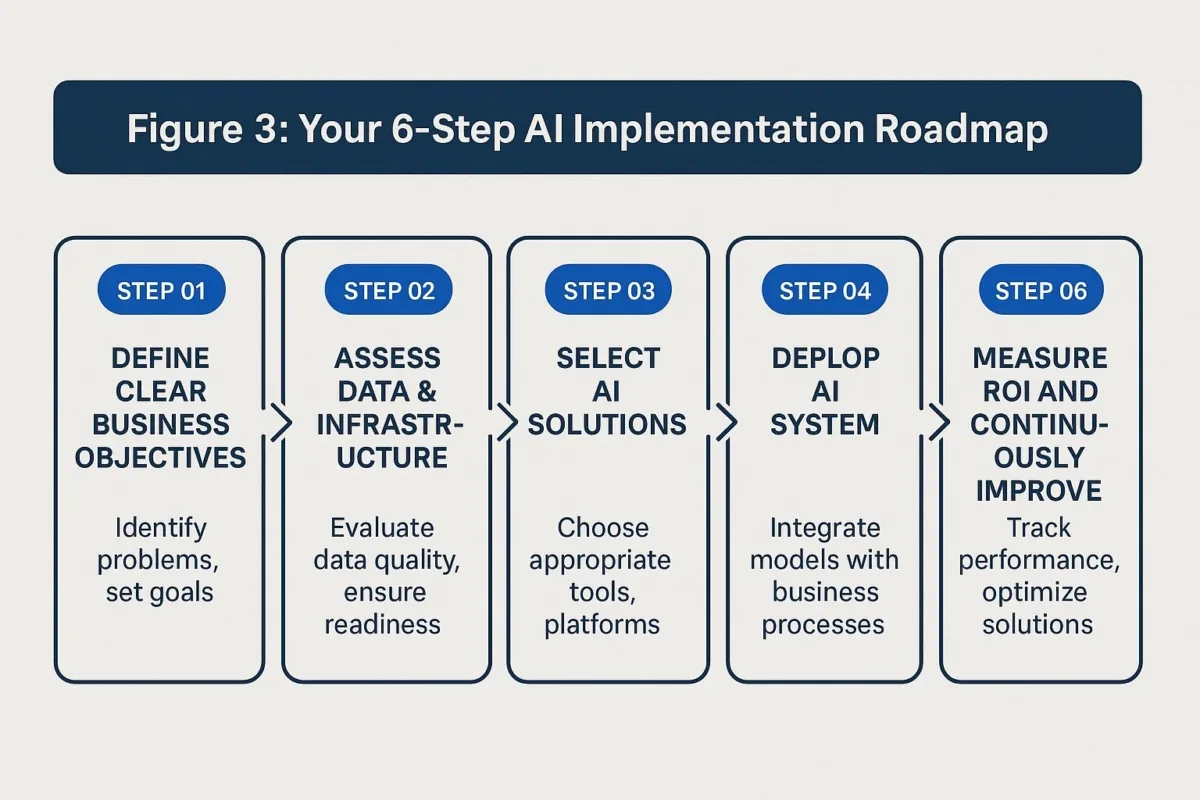
With potential use cases identified, the next question is how to move from idea to integrated solution. A successful AI journey requires a structured, phased approach that de-risks the investment and builds momentum over time. Based on best practices from numerous successful implementations, a realistic roadmap consists of six key steps.
Step 1: Define Clear Business Objectives Resist the temptation to pursue AI for its own sake. The most successful projects start by pinpointing a specific, measurable business problem. These goals should be SMART (Specific, Measurable, Achievable, Relevant, and Time-bound) and tied to clear KPIs that will be used to judge success later. For example, a weak goal is "improve sales efficiency." A strong, SMART goal is "Reduce the time to generate a qualified RFP response from 40 hours to 24 hours by the end of Q3, as measured by our project management software."
Step 2: Assess Your AI Readiness This is a critical, and often skipped, diagnostic step. Before committing significant resources, perform an honest evaluation of your organization's current state across three pillars:
- Data: Is your data accurate, complete, accessible, and well-governed?
- Technology: Is your existing infrastructure (e.g., CRM, ERP) capable of integrating with AI tools? Does it have modern APIs?
Talent: Do you have the necessary in-house skills in data science, engineering, and change management?
This readiness assessment will determine the true scope and feasibility of your project and highlight foundational work that may be needed first.
Step 3: Choose Your Path and Launch a Pilot Based on your objectives and readiness assessment, decide on your sourcing strategy: will you buy an off-the-shelf tool, build a custom solution in-house, or work with a partner? (More on this in Section 7). Regardless of the path, the next action is crucial: start with a pilot project or Proof of Concept (PoC). A pilot allows you to test the AI solution in real-world conditions with a limited user group. This de-risks the financial investment, uncovers potential challenges on a small scale, and helps build the business case and momentum for a wider rollout.
Step 4: Develop and Integrate This is the execution phase where the AI solution is built, configured, and integrated into your existing workflows. If you're pursuing a custom solution, this is where a specialized development partner like Baytech Consulting would take the lead, transforming the strategic plans and pilot learnings into a robust, scalable, and practical application. This phase must be guided by strong principles of data security, privacy, and responsible, ethical AI use.
Step 5: Train and Engage Your Team A brilliant AI tool that no one uses is worthless. Change management must be planned from the very beginning of the project, not as an afterthought. This involves more than just a one-off training session. It requires providing hands-on workshops, creating intuitive user interfaces, communicating early and often about how the tool will augment (not replace) jobs, and establishing clear feedback loops to address user concerns and continuously refine the solution.
Step 6: Measure ROI and Continuously Improve Once the solution is deployed, the journey isn't over. It's time to circle back to the KPIs defined in Step 1 and measure the actual return on investment. AI is not a static, one-and-done implementation. The data it uses changes, market conditions shift, and user needs evolve. Therefore, AI models must be continuously monitored, retrained, and improved to maintain their accuracy and value over time.
This roadmap reveals that AI implementation is fundamentally different from traditional IT projects. It is not a linear process with a defined start and end, but an iterative, cyclical one. The inclusion of steps like "Pilot," "Measure ROI," and "Continuously Improve" underscores this reality. The development process itself is best described as "Build, Review, Improve—Repeat Until It Works". This has significant implications for how executives, particularly CFOs, should approach budgeting. AI initiatives should be funded not as a single, large capital expenditure (CapEx) with a fixed outcome, but as an ongoing operational expenditure (OpEx) that accounts for continuous cycles of experimentation, learning, and refinement. The budget must be flexible enough to accommodate this agile nature, where success is defined not by a single launch date, but by a sustained process of improvement.
Our Data is a Mess. How 'Ready' Does It Need to Be?
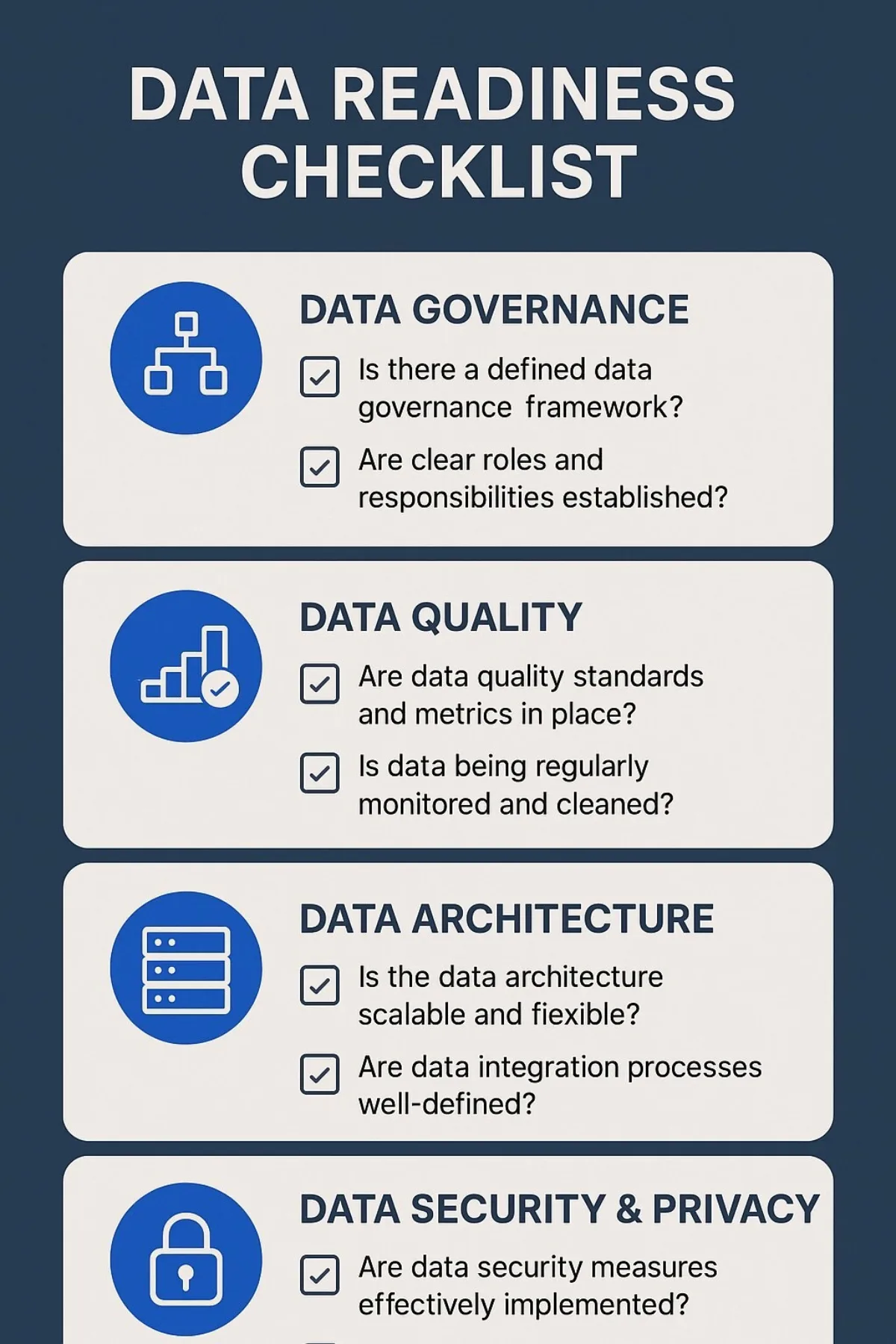
If there is one universal truth in AI adoption, it is this: data is the foundation of everything. The most common and critical blocker to success is poor data quality and management. The old adage "garbage in, garbage out" is amplified exponentially with AI. In fact, data-related challenges are so significant that they are responsible for the failure of roughly one-third of all corporate AI programs. High-quality, well-governed data is the non-negotiable "lifeblood" of any successful AI system.
Many executives, upon hearing this, throw up their hands in despair, believing their data is too messy to even begin. However, you don't need perfect data to start, but you absolutely need a plan to assess and improve it. This process begins with a structured data readiness assessment. This is a foundational service that an experienced partner like Baytech Consulting often provides, conducting a thorough audit to identify critical gaps before a single line of code for an AI model is written.
To help you begin this internal conversation, the following checklist provides a framework for evaluating your organization's data maturity. It transforms the abstract problem of "messy data" into a concrete set of questions for your technology and business teams.
| Factor | Key Questions for Your Team | Why It Matters for AI |
|---|---|---|
| Data Governance | Are data policies clearly defined and enforced? Is ownership for key datasets established? Are there clear rules for data access, usage, and privacy? | Ensures compliance, security, and accountability. Without clear governance, you risk misuse of data, regulatory fines, and a lack of trust in the AI's outputs. |
| Data Quality | Are there robust processes for data cleaning, validation, and handling inconsistencies? Is data complete and accurate? How do you prevent poor quality data from being injected upstream? | AI models trained on inaccurate, incomplete, or biased data will produce flawed, biased, and unreliable results, potentially leading to disastrous business decisions. |
| Data Architecture | Is your data consolidated or is it trapped in silos across different systems (e.g., CRM, ERP, marketing platforms)? Do you have a scalable data architecture (e.g., data lake, data warehouse) that can support AI workloads? | AI needs access to integrated, holistic data sources to identify meaningful patterns and generate powerful insights. Data silos are a primary obstacle to effective AI. |
| Data Security & Privacy | Are there strong policies and technical controls to safeguard sensitive data (customer, financial, employee)? How is data anonymized for training? Are you compliant with regulations like GDPR and CCPA? | AI models often require access to vast and sensitive datasets. A failure to secure this data can lead to catastrophic breaches, legal liability, and severe reputational damage. |
This assessment process often leads to a profound realization. The most forward-looking, data-driven companies are fundamentally shifting their perspective: they are beginning to treat their data as a product, not a byproduct. In a traditional IT model, data is often seen as a secondary output of an application—for example, the customer data that happens to reside in the CRM. A "data as a product" mindset, in contrast, treats the data itself as a valuable asset. It has a dedicated owner (a data steward), defined quality standards, a managed lifecycle, and is intentionally designed to be easily and securely consumed by multiple downstream applications, including a wide range of AI tools.
This represents a significant organizational and financial shift. It means investing in the less glamorous but more critical foundational layers of an AI strategy: data engineers, data governance teams, and modern data infrastructure. For a CFO, this means allocating budget not just to the shiny new AI application, but to the underlying data platform that will enable it. The ROI of adopting a "data as a product" approach is not measured by a single project's success; it's measured by its ability to accelerate and de-risk
all future AI initiatives across the entire enterprise.
How Do We Integrate AI with Our Existing CRM and ERP Systems?
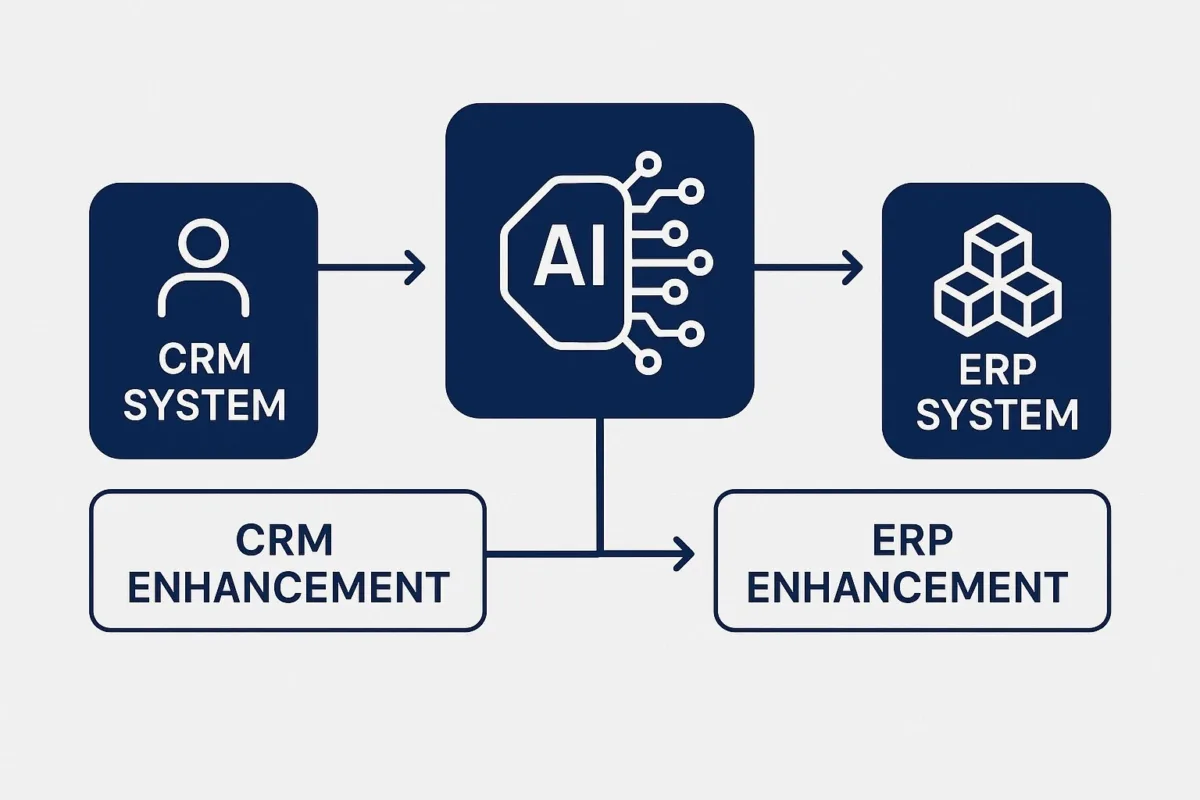
For AI to deliver real business value, it cannot exist in a vacuum. It must be woven into the fabric of the enterprise, enhancing the core systems that teams use every single day, such as Customer Relationship Management (CRM) and Enterprise Resource Planning (ERP) platforms. The goal is not to introduce yet another standalone dashboard that employees have to remember to check; the goal is to make your existing systems smarter and more proactive.
By integrating AI, these platforms transform from passive systems of record into active engines of insight and automation.
Common Integration Use Cases:
- CRM Enhancement: Integrating AI with a CRM can supercharge sales and marketing efforts. For example, AI can analyze customer behavior and engagement history to automatically score and prioritize leads, allowing sales teams to focus on the most promising opportunities. It can provide predictive analytics to identify which existing customers are at risk of churn or which are prime for an upsell. In marketing, it can personalize email campaigns at scale and power intelligent chatbots that provide instant, 24/7 customer support, dramatically improving customer satisfaction.
- ERP Enhancement: When integrated with an ERP system, AI can drive significant operational efficiencies. It can analyze historical sales data, market trends, and even external factors like weather patterns to produce far more accurate demand forecasts. This, in turn, allows for optimized inventory management, reducing both stockouts and costly overstock situations. AI can also enhance supply chain management by assessing supplier risk and predicting potential disruptions before they occur.
While the potential is enormous, integrating AI with these complex enterprise systems presents several practical challenges. Successfully navigating them requires a deliberate and strategic approach.
Key Challenges & Best Practices:
- Challenge: Legacy Systems. A primary hurdle for many organizations is that their existing ERP and CRM platforms are legacy systems that were not designed for the AI era. They often lack modern, well-documented Application Programming Interfaces (APIs), making it complex and costly to connect them to external AI models.
- Best Practice: Adopt an API-First Approach. The most effective way to bridge this gap is to prioritize an API-first integration strategy. This involves using middleware or building custom API gateways that allow your legacy systems to communicate seamlessly with modern AI services. This creates a more flexible, modular, and scalable architecture that can adapt as both your enterprise systems and AI technologies evolve.
- Challenge: Data Silos. Even with modern systems, data is often siloed. Customer data in the CRM is separate from financial data in the ERP, which is separate from marketing data in another platform. AI needs a unified view to generate the most powerful insights.
- Best Practice: Start with a Phased Integration and Pilot Project. Do not attempt to integrate everything at once. A "boil the ocean" approach is a recipe for failure. Instead, start with a tightly scoped pilot project that focuses on a single, high-value integration point—for example, adding an AI-powered lead scoring feature to your CRM. This allows you to prove the value of the integration, learn about the technical hurdles on a small scale, and build the business case for more complex, cross-system integrations later.
- Challenge: System Compatibility. Not all enterprise systems are "AI-ready." Their underlying data structures or technical limitations may make integration difficult.
- Best Practice: Evaluate Your Systems First. A critical first step in the integration process is to conduct a thorough technical assessment of your existing CRM and ERP platforms. Understand their data formats, API capabilities, and any limitations. In some cases, you may need to plan for a system upgrade. In others, you may need to work with a specialized partner like Baytech Consulting to build the custom connectors and data pipelines necessary to make the integration possible.
Tackling these integration challenges often has a powerful, secondary benefit. The push to integrate AI frequently becomes the catalyst that forces a long-overdue conversation about modernizing the company's entire enterprise architecture. The technical barriers to AI—like rigid, monolithic systems and a lack of APIs—are often the same barriers hindering overall business agility. By making the business case for an AI project, a CTO can often secure the necessary funding and executive support to address years of technical debt, moving the organization towards a more modern, modular, and interconnected architecture. The ROI of the AI project, therefore, extends beyond its direct output; it includes the enabling of greater agility and innovation for the entire organization for years to come.
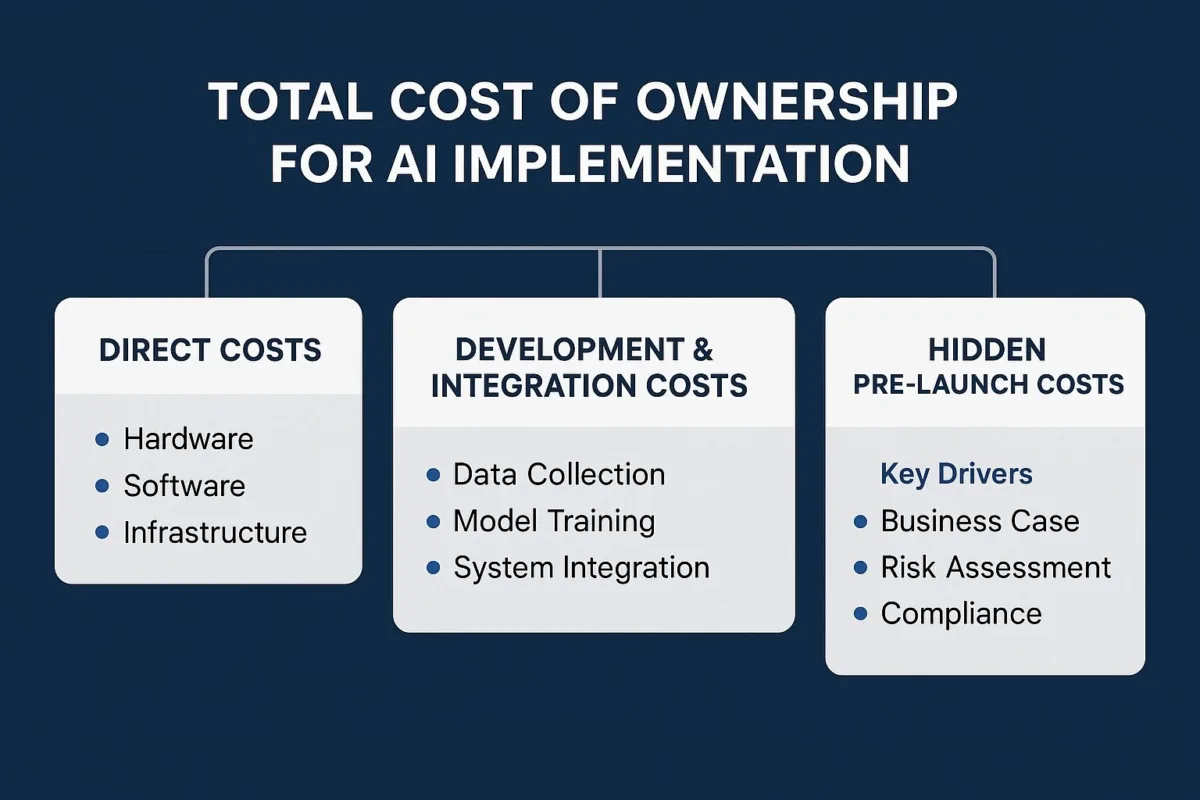
What Are the Real Costs? Give Me a TCO Breakdown
For any executive, and especially for a CFO, the most pressing question about AI is the cost. While the potential ROI is compelling, the investment required can be substantial and, more importantly, is often misunderstood. The "sticker price" of an AI platform or the initial development cost of a custom solution is only a small part of the financial picture. A true understanding requires a full analysis of the Total Cost of Ownership (TCO), which includes significant direct, hidden, and ongoing costs that can dramatically impact the budget if not anticipated.
To move the conversation from a vague "it's expensive" to a structured financial plan, here is a detailed breakdown of the real costs of an AI implementation.
| Cost Category | Component | Estimated Cost Range / Key Driver | Why It's a Key Cost |
|---|---|---|---|
| 1. Direct Costs (Platform & Infra) | Software/API Licenses | API usage for models like GPT-4 can range from $500 to $5,000+ per month, scaling directly with interaction volume. | This is the operational "fuel" for your AI. Higher usage means higher costs, requiring careful monitoring and prompt optimization. |
| 1. Direct Costs (Platform & Infra) | Hardware / Cloud Compute | An on-premise GPU cluster can start at $500,000. Cloud compute for training and inference typically runs $2,000 to $10,000+ per month. | AI model training is one of the most computationally intensive and expensive processes in modern IT. |
| 2. Development & Integration Costs | Talent (In-house vs. Outsource) | A US-based Data Scientist can cost $100-150/hour, while an outsourced equivalent might be $40-70/hour. Talent can represent up to 60% of the total project budget. | The talent gap makes skilled AI professionals the single biggest cost driver. Their expertise is scarce and commands a premium. |
| 2. Development & Integration Costs | Integration with Legacy Systems | Can add $5,000 to $100,000+ to a project's cost. | Connecting AI to older, non-API-ready systems often requires significant custom development work to build bridges. |
| 3. Hidden Pre-Launch Costs | Data Acquisition & Preparation | This can consume 15-30% of the total project budget. Manual data labeling alone can cost upwards of $30,000. | This is the most consistently underestimated cost in AI projects. Starting with poor data quality guarantees project failure and wasted investment. |
| 3. Hidden Pre-Launch Costs | Discovery & Planning | Typically 5-15% of the total project cost. | Investing in a solid strategy, readiness assessment, and pilot plan upfront prevents costly rework and changes in direction later. |
| 4. Ongoing Post-Launch Costs | Model Monitoring & Retraining | Estimated at 5-10% of the initial development cost annually. | AI models are not static. They "drift" and lose accuracy over time as data patterns change, requiring continuous maintenance to remain effective. |
| 4. Ongoing Post-Launch Costs | Infrastructure Scaling & Maintenance | Adds 5-15% of the initial development cost annually. Cloud data storage can add $200 to $2,000+ per month. | As your user base and data volumes grow, so do the infrastructure costs required to support them. |
| 4. Ongoing Post-Launch Costs | Regulatory & Compliance Updates | Can range from 2-15% of the initial development cost annually. | New regulations, such as the EU AI Act, can force expensive and time-consuming model audits, adjustments, or even complete rebuilds. |
This breakdown reveals that the most significant "hidden" costs are not purely technical; they are centered around data and people. The budget line items for data preparation and talent acquisition often dwarf the costs of the software or hardware itself. Furthermore, there are significant indirect costs associated with inefficiency. An expensive GPU cluster sitting idle or a high-priced AI team stalled on a project due to a lack of clean data represents a massive waste of resources.
This reframes the financial strategy for AI. The most effective way to control long-term AI costs is not by negotiating cheaper compute time, but by investing proactively in a robust data strategy and adopting a flexible talent model. This is where the decision to work with a specialized partner like Baytech Consulting becomes a strategic financial choice, not just a technical one. Outsourcing the development can convert what would be a massive, high-risk upfront capital expenditure—the cost and time of recruiting, hiring, and training a full-time in-house team—into a more predictable, scalable, and manageable operational expenditure. It allows a company to access elite talent precisely when needed without carrying the long-term overhead, fundamentally de-risking the entire financial commitment of the AI initiative.
Should We Build In-House, Buy Off-the-Shelf, or Hire a Partner?
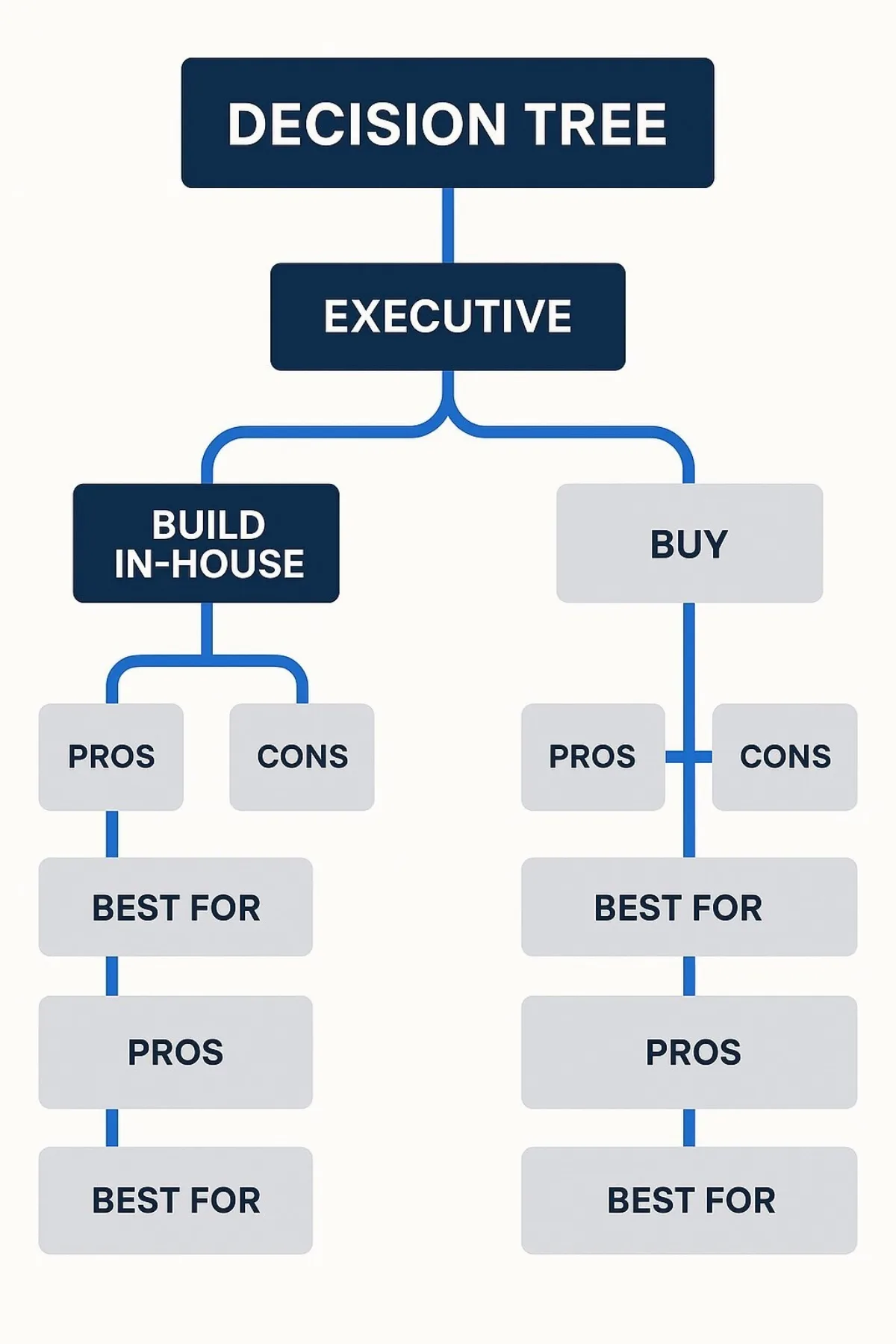
After defining the use case, assessing readiness, and understanding the costs, the final strategic decision is how to source the solution. This choice—whether to build a custom solution with an in-house team, buy a pre-packaged off-the-shelf product, or partner with a specialized development firm—will have profound implications for the project's cost, timeline, and ultimate success.
Here is a balanced analysis of the three primary paths:
1. Buy (Off-the-Shelf Solutions) Off-the-shelf AI tools are pre-built, often SaaS-based products designed to solve common business problems.
- Pros: The primary advantages are speed and lower initial cost. Deployment can happen in days, not months, and subscription-based pricing avoids large upfront capital outlays. These tools are often battle-tested across thousands of users and come with vendor support and regular updates.
- Cons: The significant drawback is a lack of customization. Your business must adapt its workflows to the tool, not the other way around. This rigidity can stifle innovation and create a competitive disadvantage. Other concerns include potential scalability limitations, data privacy issues (as your data is processed on a third-party platform), and the risk of vendor lock-in.
- Best For: Standard, non-strategic tasks where a generic solution is "good enough" and speed is the most critical factor. A good example is implementing a basic FAQ chatbot for a website.
2. Build (In-House Team) This approach involves hiring and managing a dedicated internal team of data scientists, ML engineers, and developers to create a completely proprietary AI solution.
- Pros: The main benefit is total control. You own the intellectual property (IP), can customize the solution precisely to your unique business processes, and build a deep well of internal expertise. For capabilities that are truly core to your long-term competitive advantage, this offers the most strategic alignment.
- Cons: This is by far the most expensive, slowest, and riskiest path. The cost of recruiting, hiring, and retaining scarce AI talent is astronomical, with salaries for AI engineers rising 25-30% year-over-year. The hiring process itself can take months, delaying the project start. It requires a massive upfront investment in salaries, benefits, and infrastructure, and it is very difficult to scale the team up or down as project needs change.
- Best For: Large, mature enterprises where the AI capability being built is a central pillar of the company's future strategy, and where budget and time-to-market are not the primary constraints.
3. Partner (Outsourcing to a Specialized Firm) This model involves hiring an external firm, like Baytech Consulting, to design, develop, and integrate a custom AI solution.
- Pros: This approach offers a strategic balance of customization and practicality. You gain immediate access to a team of specialized experts without the time and expense of recruiting them yourself. This dramatically accelerates the speed-to-market compared to building in-house. It is significantly more cost-effective than hiring a full-time team, converting a large fixed cost into a flexible project-based expense. A good partner brings proven, agile development processes, deep industry knowledge, and the flexibility to scale resources up or down as needed, mitigating risk.
- Cons: This model offers less direct, day-to-day control than an in-house team. Success is highly dependent on selecting the right partner and maintaining strong, transparent communication. There are also potential security and IP risks if the partner is not properly vetted and appropriate legal agreements are not in place.
- Best For: The vast majority of B2B companies that require a custom AI solution to gain a competitive edge but lack the internal expertise, budget, or time to build it entirely themselves. It is the ideal model for developing pilot projects, creating Minimum Viable Products (MVPs), and tackling complex system integrations.
Ultimately, the "build vs. buy" framing presents a false dichotomy. The more strategic question for leaders is: "What is our unique core competency that we must own, and what specialized functions are better executed by an expert partner?" As one expert notes, "You outsource to get a proven software development process so you can focus on your own core competency".
For most organizations, the internal team's core competency should be defining the business problem, owning the data strategy, and driving user adoption. The highly specialized, technical work of building, training, and integrating the AI model itself is a function that can and often should be outsourced to a trusted partner like Baytech Consulting. This hybrid approach allows the business to maintain complete strategic control while leveraging external expertise for execution, optimizing for cost, speed, and focus.
Where's the Proof? Show Me Real-World B2B Success Stories
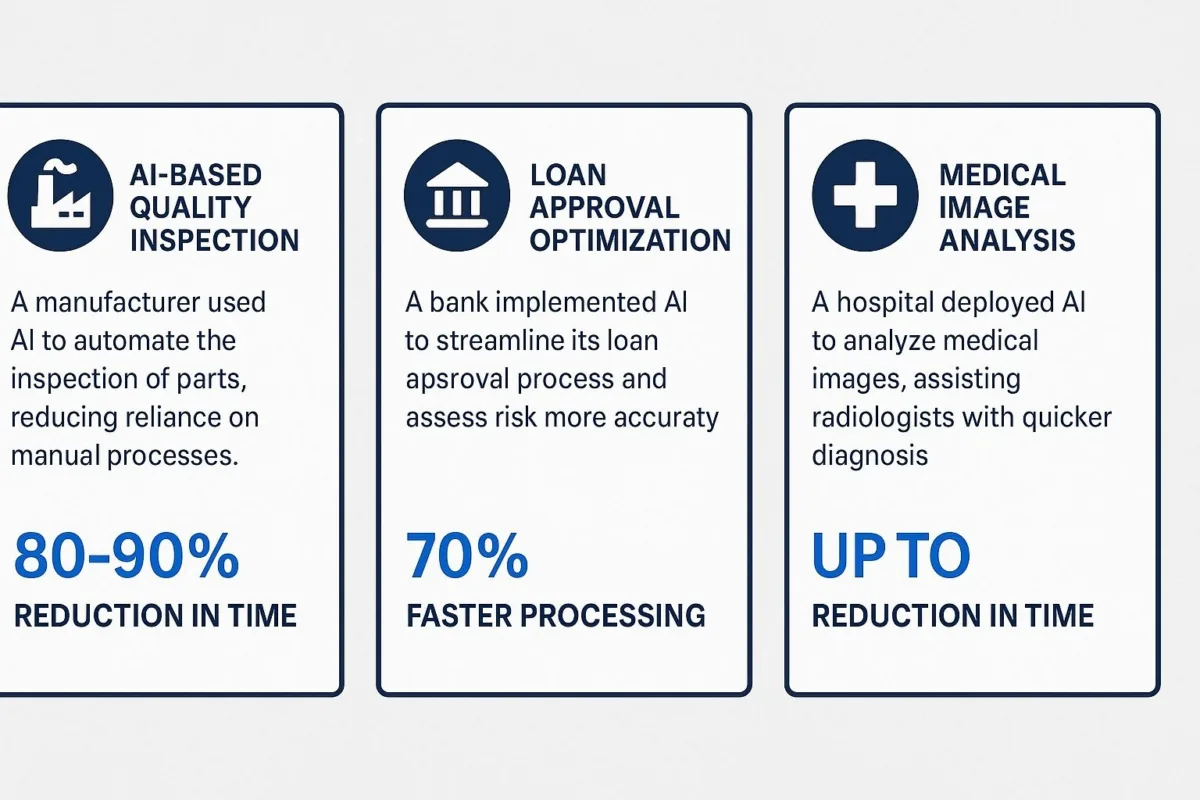
Theory and frameworks are essential, but for business leaders, the ultimate proof is in the results. The good news is that across B2B industries, companies are already leveraging AI to achieve transformative, quantifiable outcomes. These are not hypothetical future gains; they are documented successes happening today.
Here are a few powerful examples of AI delivering real value in a B2B context:
Case Study 1: Supercharging Sales in the Industrial Sector
- Company: An industrial materials distributor.
- Problem: The company's growth was stagnating. Their sales team relied on slow, manual processes to identify new construction projects, leaving significant opportunities on the table.
- AI Solution: They built a custom AI engine that integrated with their CRM and analyzed unstructured public data, such as municipal construction permits. The generative AI model could extract key insights from these documents to automatically identify and qualify new projects, prioritize the most valuable leads for the sales team, and even generate hyper-personalized outreach emails at scale.
- Quantifiable Result: In the first year, the AI solution generated over $1 billion in new opportunities, representing a 10% increase in their total pipeline, and the personalized emails achieved double the click-through rates of their previous manual efforts.
Case Study 2: Revolutionizing B2B Payments and Reconciliation
- Company: Mastercard.
- Problem: The process of reconciling invoices with payments was a highly manual, time-consuming, and error-prone back-office function, creating delays and increasing operational costs.
- AI Solution: The company deployed "Smart Data," an AI-driven platform designed to automate the complex task of matching incoming payments to their corresponding invoices across millions of transactions.
- Quantifiable Result: The AI platform reduced the processing time for reconciliation by 50%, freeing up finance teams to focus on more strategic analysis and significantly improving cash flow efficiency.
Case Study 3: Streamlining B2B Healthcare Services
- Company: Deloitte, providing a solution for a healthcare client.
- Problem: Patients seeking care and the support staff assisting them were spending an excessive amount of time on the phone—an average of five to eight minutes per call—simply trying to find healthcare providers who were in their insurance network.
- AI Solution: Deloitte built a "Care Finder" AI agent using Google Cloud's conversational AI technology. The agent was trained on the healthcare provider's complex and often siloed network data.
- Quantifiable Result: The AI agent can now help patients and staff find an appropriate, in-network provider in less than one minute, an 80-90% reduction in time that dramatically improves the user experience and frees up support staff for more complex issues.
A common thread runs through these success stories. While generic AI tools trained on public internet data are useful for general tasks like drafting copy, the most powerful and defensible B2B use cases emerge from applying AI to proprietary, internal, or hard-to-access data. The industrial distributor's success came from combining its internal sales data with external permit data. Mastercard's solution leveraged its vast trove of internal transaction data. The healthcare agent's value came from its ability to navigate complex, siloed provider network data.
This underscores the core value proposition of working with a custom software development partner. A firm like Baytech Consulting doesn't just provide access to AI algorithms; they build the secure, robust systems that can connect to your unique and most valuable data sources—your CRM, your ERP, your proprietary databases—and apply AI to unlock insights and create a competitive advantage that no off-the-shelf tool could ever replicate.
Conclusion: Your First Step Towards an AI-Driven Future
The journey to becoming an AI-driven organization can seem daunting, but it is no longer optional. The evidence is clear: AI is a core strategic driver of productivity, efficiency, and competitive reinvention. As this guide has shown, the path to success is not paved with complex technology for its own sake, but with a clear-eyed focus on solving specific business problems. The foundation for everything is not the algorithm, but the quality and governance of your data.
The journey of a thousand miles begins with a single step, and in AI, that first step is not a massive, high-risk investment. It is a low-risk, high-value action: conducting a thorough readiness assessment and identifying a single, tightly-scoped pilot project to prove the potential within your own organization.
The question for every B2B leader is no longer if your organization will adopt AI, but how you will manage the transition. The path from a promising idea to a scalable, secure, and fully integrated solution is complex, but it is a path you do not have to walk alone. A strategic partner can provide the map, the tools, and the expertise to help you navigate the terrain successfully.
If you are ready to move from discussion to action, the first step is a conversation. Reach out to the experts at Baytech Consulting to help you build your AI readiness assessment and craft a roadmap for your first custom AI solution. Gain confidence knowing you have a partner experienced in strategic system integration and AI-enabled software development—your next move toward sustainable growth.
About Baytech
At Baytech Consulting, we specialize in guiding businesses through this process, helping you build scalable, efficient, and high-performing software that evolves with your needs. Our MVP first approach helps our clients minimize upfront costs and maximize ROI. Ready to take the next step in your software development journey? Contact us today to learn how we can help you achieve your goals with a phased development approach.
About the Author

Bryan Reynolds is an accomplished technology executive with more than 25 years of experience leading innovation in the software industry. As the CEO and founder of Baytech Consulting, he has built a reputation for delivering custom software solutions that help businesses streamline operations, enhance customer experiences, and drive growth.
Bryan’s expertise spans custom software development, cloud infrastructure, artificial intelligence, and strategic business consulting, making him a trusted advisor and thought leader across a wide range of industries.


